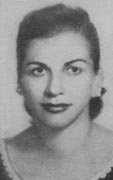General Rafael Leonidas Trujillo came to power in 1930 and established an oppressive dictatorship in the Dominican Republic that lasted until his assassination in 1961. El Jefe (The Chief), as Trujillo was called, used his secret police to make arrests at will. Civil liberties were nonexistent, and brutality and terror dominated his regime. Dominicans were required to hang a picture of Trujillo in their homes and schoolchildren taught to revere him. In 1936, he changed the name of the capital city Santo Domingo to Cuidad Trujillo (Trujillo City).
One of the most infamous episodes of his dictatorship was the massacre of thousands of Haitian citizens in 1937. Trujillo’s soldiers murdered Haitians working as sugar cane cutters or living in Dominican territory. Estimates of the men, women and children killed range from 13,000 to 20,000.
The Butterflies, or Las Mariposas, became the code name of Patria, Minerva and Maria Teresa Mirabal, three sisters who led an underground movement to overthrow Trujillo. They were born in Ojo de Agua near the city of Salcedo to Enrique Mirabal and Maria Mercedes Maribal.
Early relationships and incidents began Minerva’s political questioning and eventual commitment to the underground movement. Minerva became friends with students at her Catholic boarding school whose relatives had been arrested, tortured or killed by Trujillo’s men. At a dance, Minerva slapped Trijullo for making sexual advances towards her. Soon after, she was briefly jailed and her father was imprisoned for two years. Fifteen days after his release he died from malnutrition and beatings.
Patria and Maria Teresa joined their sister in her political activities. The sisters married men who were also anti-Trujillo and together the three couples organized underground opposition. A fourth sister, Dede, was forbidden by her husband to take part in her sisters’ political activities.
Trujillo crushed an insurrection attempt in 1949 when exiled Dominicans tried to overthrow the government. Exiles tried to invade again on June 14, 1959 but were killed. The failed invasion inspired an organization for internal resistance known as the 14th of June Movement. The Mirabal sisters and Alvarez’s parents joined the movement, which planned to assassinate Trujillo in January of 1960. The plan was uncovered and movement members fled or were imprisoned; many were killed.
On November 25, 1960, the three “Butterflies” were returning from a visit to Minerva and Patria’s husbands in a distant prison. Trujillo’s men ambushed them on an isolated mountain road and beat them and their driver to death.
The Butterflies became symbols of courage, dignity and strength in their country. Their deaths galvanized the political insurrection that led to Trujillo’s assassination in 1961. Today, November 25 is observed in many Latin American countries as the International Day Against Violence Against Women in memory of the Mirabal sisters.
Sources
- "Warning Beneath the Cliff." Time, December 12, 1960.
- "In the Time of the Butterflies." Novels for Students, Vol. 9. Gale, 2000.
Content last updated: October 31, 2004


